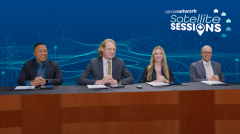
Triplet Induction Therapy in Patients With Transplant-Eligible NDMM
Focused discussion on the historical use of triplet regimens as induction therapy in transplant-eligible newly diagnosed multiple myeloma.
Episodes in this series

Transcript:
Andrew P. Dalovisio, MD: I want to dive into the idea of triplet vs quadruplet induction regimens for patients.I think, to do that, you have to take a little stroll down memory lane. The 1960s was the first time they ever actually showed any effective treatment for multiple myeloma [MM], which was prednisone, which actually didn't really give deep responses or lasting responses, but it showed some efficacy. It wasn't really until the 1970s that they introduced alkylators like melphalan along with prednisone and even standard chemotherapy that they began to see some responses although they still were not good. Then moving into the 1980s, they found that combining these alkylators, steroids, and then moving into things like autologous transplant actually provided the longest durations of remission to date and survival to date. And then, as we moved into the 2000s with the approval of Velcade [bortezomib] in 2003 and Revlimid [lenalidomide] in 2006, that was built on, and then we got into the monoclonal antibodies, and now we're into CAR T [chimeric antigen receptor T-cell therapy] and bispecifics and things. The survival rate for myeloma was somewhere in the 3- to 6-month range in the 1960s for standard-risk patients, it's now almost 10 years and sometimes longer. So we've made a lot of advances.
Now, there's a lot of trials that led to the approvals of doublets like rev/dex [lenalidomide and dexamethasone] and vel/dex [bortezomib and dexamethasone] that were done in the early 2000s, but obviously, that thought was, "Well, what if we build on that, combining those drugs and things like that?" So a few trials, I think, that are important to run through when we talk about triplet, because that'll eventually lead to our quadruplet conversation, and also the use of stem-cell transplants. The first one was the SWOG 0777 [NCT 00644228-D1] study that was done from 2008 to 2012. And this is really the study that put RVd [lenalidomide, bortezomib, and dexamethasone] on the map. It was a randomized trial, it didn't study the role of transplant, but it randomized patients to get RVd vs RD, and at a follow-up of 84 months, they had a PFS [progression-free survival] of 41 months in the triplet arm vs 29 months in the RD arm. And the median overall survival [OS] has still not been reached at that time point of analysis.
So, what this study did was put VRd on the map as an induction regimen in MM. Then that led to the, "Well, what if we do triplet and then transplant?" That led to 2 of the major transplant trials that put early transplant triplet therapy modeled by early transplant followed by maintenance on the map, the first one being the IFM trial [NCT03993912], which was done between 2010 and 2012 where patients got triplet, auto, then Rev maintenance for just 1 year, and at a median follow-up of 89 or 90 months, the median PFS was 47 months, so 4 years in the auto group vs just 3 years in the RVd group. So a clear benefit to early transplant with regard to PFS, but not OS.
Now, the DETERMINATION trial [NCT01208662], which was done at the same time and was much more of a United-States-based study, really had the same schema with the exception that the patient stayed on Revlimid maintenance until progression or intolerance, and at a median follow-up of 76 months, the PFS was 46 months in the non-transplant arm in 67 months, so almost 6 to 7 years in the transplant group. So the 2-year difference between the IFM trial and the DETERMINATION trial and PFS almost certainly had to do with the fact that Revlimid was continued indefinitely. So, based on these trials, I think, triplet therapy got put on the map as a standard, really, up until pretty recently. And I would ask, Ryan, are there ever situations now where you give just 2 drugs upfront in induction in a transplant-eligible patient?
Ryan P. Griffin, MD: No, so, for a transplant-eligible patient newly diagnosed, I don't think there's a role for doublets anymore, and I'm sure you're going to be getting to this, but I guess the question is going to be, are triplets enough for a newly-diagnosed transplant-eligible patient?
Andrew P. Dalovisio, MD: Absolutely, I think that, as you said, fortunately, we don't see too many people getting doublets anymore in the transplant-eligible setting, occasionally, it sometimes happens, pretty much everyone's getting triplets, but we're really trying to push people into the quadruplet space. I do think that one important topic to talk about as I move into the quadruplet studies is the concept of MRD or minimal residual disease that with IMWG staging, where you looked at SPEP [serum protein electrophoresis] immunofixation light chains, when you actually measure those, even if they were negative, patients could still have 1 times 10 to the 8th myeloma cells in their body, so billions of myeloma cells still in their body despite being a stringent complete remission. So, really, that kind of tip-of-the-iceberg phenomenon.
As these IFM trials and DETERMINATION trials were being done, it wasn't until the DETERMINATION trial that they started incorporating some MRD [minimal residual disease] data. But, really, I think that needs to be our endpoint and goal moving forward, because we're planning patients that can get into that MRD state, and whether that's measured by next-generation flow or next-gen sequencing, down to 1 times 10 to the negative 5th or 6th remission that we've found from a large retrospective meta-analysis that those patients do better. So really, we're focusing on the goal of MRD negativity, and then there's some thought, do we even need to be thinking about stringent and complete remission and IMWG responses, do they really even matter?
Transcript edited for clarity.
Newsletter
Stay up to date on recent advances in the multidisciplinary approach to cancer.


















































































